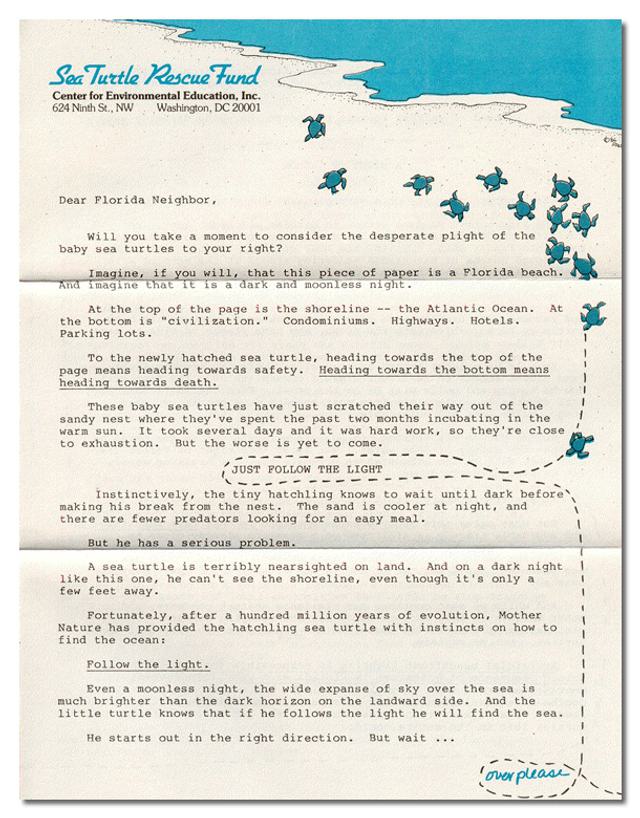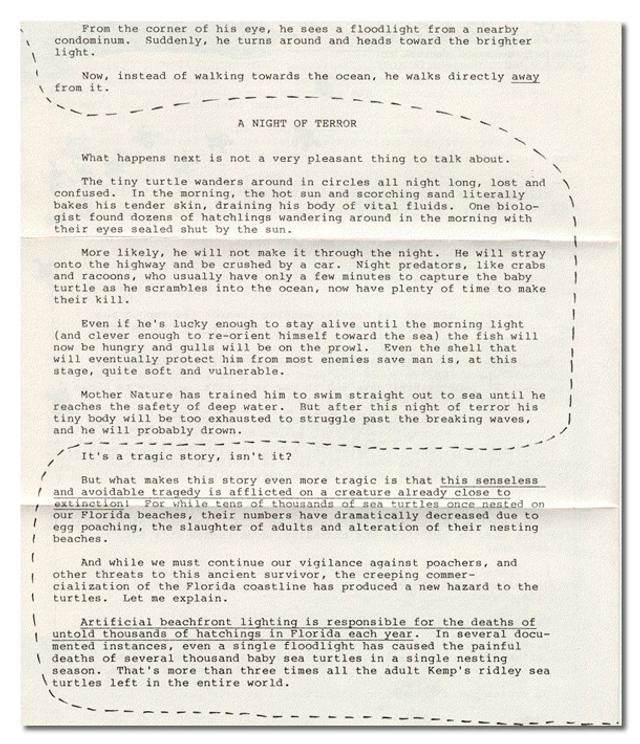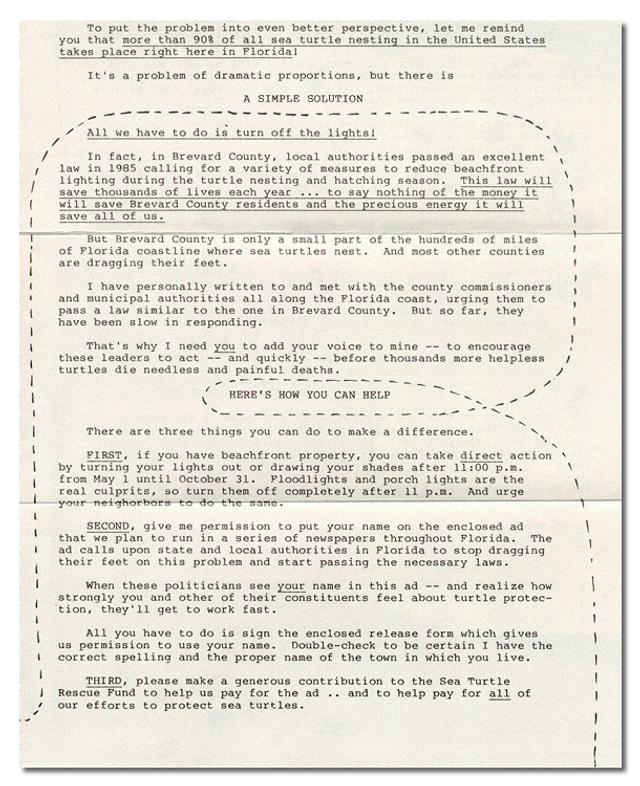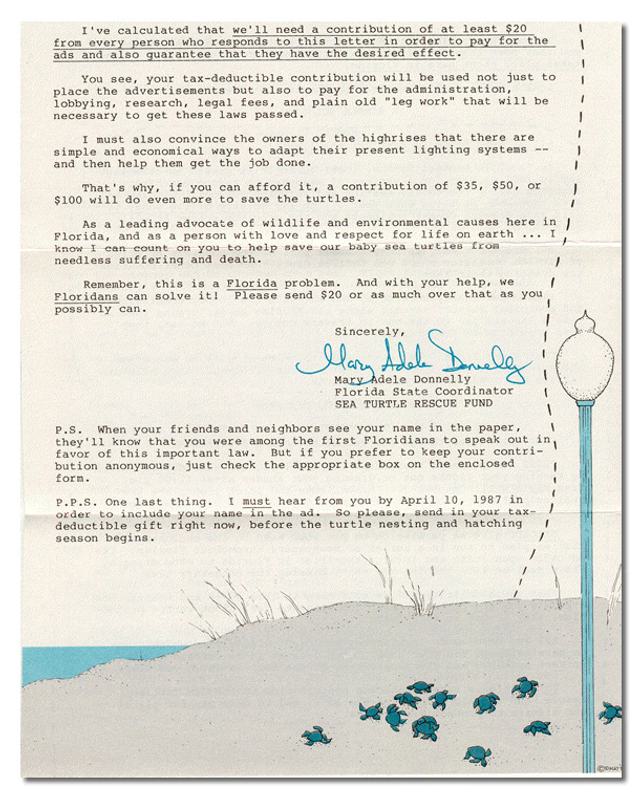How I wrote it: why I owe my career to a sea turtle
In this article, Richard Armstong, a freelance copy writer based in the USA, talks to Fergal Byrne about a successful direct mail letter that he wrote in 1982.
- Written by
- Fergal Byrne
- Added
- June 25, 2012
 View original image
View original image
The direct marketing agency, Lautman & Company had hired Richard Armstong to write what he anticipated to be a routine fundraising package for the Center for Environmental Education. It seems there was a problem developing on the beaches of Florida; bright lights from beachfront properties were distracting hatchling sea turtles on their way to the ocean, reducing their chances of survival. In response, the Center for Environmental Education created the Sea Turtle Rescue Fund.
The solution: increasing public education. If people who lived along the beach could be persuaded to switch off their outside lights at night, a greater number of baby sea turtles would be able to reach the safety of the ocean. Richard takes up the story.
‘Our direct-mail package asked people to help pay for full-page newspaper ads throughout the state of Florida. This aimed to educate people about the plight of the baby sea turtles and encourage them to turn off their beachfront lights.’ Richard’s role was to create an effective concept for this direct-mail appeal. As a result, he developed a cartoon-like theme, starting with the envelope, of a baby sea turtle hatching out of his egg, saying:
‘Will the last person to leave the beach at night please turn out the lights! (And help save my life).’
 View original image
View original image
Inside, the letter showed an illustration of a bunch of baby sea turtles heading for the waves – except for one little turtle who gets distracted and starts wandering toward the bottom of the page. In fact, he meanders across the four-page letter, over the margins, around the sub-headlines, and so on, until he reaches the final page. Here, he finds the still shells of a few of his companions, dead beneath the harsh light of a beachfront street lamp. The letter began like this:
‘Dear Friend,
Will you consider the desperate plight of the baby sea turtles to your right? Imagine, if you will, that this piece of paper is a Florida beach. And imagine that it is a dark and moonless night. At the top of the page is the shoreline – the Atlantic Ocean. At the bottom is “civilization”. Condominiums. Highways. Hotels. Parking lots. To the newly-hatched sea turtle, heading toward the top of the page means heading toward safety. Heading toward the bottom means heading toward death.’
Richard recounts how the package proved extremely popular and, because it was something of an original piece, he decided to enter it in the 1988 International Caples Awards. And as he says:
 View original image
View original image
‘that’s when all hell broke loose…’
‘About a week before the Caples awards ceremony, I got a phone call from the late Andi Emerson, who was the doyenne of the Caples awards from its founding until her untimely death in 2008. Andi and I were old business acquaintances, having worked together on several projects in the past.
‘Richard, I’m not supposed to be calling you.’
‘Why not, Andi?’
‘It’s a secret.’
‘What’s a secret?’
‘You won.’
‘I won what?’
‘You won everything!’
‘Everything?’
‘Yes, your sea turtle thing. It won first prize in the direct-mail category.’
‘That’s great!’
‘That’s not all. It also won the Maxwell Sackheim award for best in the show.’
‘Wow!’
‘I’m not supposed to be telling you this. But I wanted to make sure you
came to the gala, because it would be embarrassing for us if you didn’t.’
‘Where is it?’
‘The grand ballroom of the Waldorf Astoria. Oh, and bring some bags.’
‘Some bags?’
‘Yeah, you’re gonna have a lot of hardware to haul home.’
 View original image
View original image
‘I brought two big sacks with me because, as Andi had joked, there was a ton of hardware – trophies for the client, for the agency, for the artists, and for me. Not just first prize trophies though – there were also best-in-show trophies, which were even more ornate. I walked out of the Waldorf Astoria with the bags slung over my shoulder like Santa Claus. Needless to say, the publicity from the event was enormous and in many ways it made my career’.
Richard remarks that he has always agreed with those who criticise awards ceremonies on the grounds that they lack relevancy to their underlying subject.
‘For example, when it comes to the Oscars, it’s no more meaningful to say one actor is better than another than it would be to say Picasso is better than Rembrandt. With respect to direct mail, the most important awards are undoubtedly a high response rate and a healthy bottom line. However, these critics miss the point. The reason we have such award ceremonies, and the reason why they continue to be worth entering, is because they’re good for business – the Caples awards were certainly great for mine’.
 View original image
View original image
So what is the lesson to be learned here? What made the sea turtle package work so well? Richard believes it received so much attention because it embraced a technique we don’t use as often as we should in direct mail copy-writing – drama.
Reading the letter is as effortless as watching the television; like watching a mini soap opera playing out before you. Combining this with the fact this was a clear-cut problem with a very simple solution, explains why the donors naturally responded with such enthusiasm’.
© Richard Armstrong's article was first published on SOFII in 2010.

Richard Armstong

Richard Armstong is a freelance copy writer based in the USA, www.freesamplebook.com.
This article was edited by Amy Cruse

Amy Cruse volunteered for SOFII in 2012. She is a graduate from the University of Southampton and is currently an editorial assistant at the Royal Pharmaceutical Society.

















